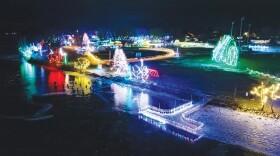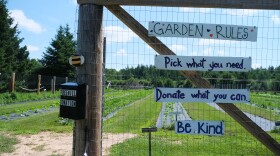Standing in the center of the large grass circle at Waaswaaganing Indian Bowl, Sonny Smart welcomes the large crowd to Lac du Flambeau.
“We want to welcome you this evening to our 75th anniversary,” announced Smart. “You're part of the 75th anniversary here at the Lac du Flambeau Waaswaaganing Bowl.”

A large part of his role as emcee is to explain what people are seeing, like why veterans are the first ones to come into the dance arena during the grand entry.
“They clear the way for all of the dancers, the tribal community. Everybody follows them. It symbolizes that they're clearing the way as they come in, and to make it a safer place for them and a good place when they come in,” Smart explained to the crowd.

Smart has been coming to the bowl since the 70s, for most of those years he would dance. For the last two, he’s been the emcee for the weekly pow wows.
It’s a natural fit for the man who is a teacher by profession.
“I come from the Fish Clan, and that's where our teachers and our philosophers and our seers come from,” said Smart. “I'm just kind of doing what part of my clan does in that part of teaching. I enjoyed doing this, teaching people about song, the dance, the people from the history.”
For Smart, there’s many lessons to be learned by experiencing a pow wow at the Indian Bowl.
Visitors can learn about the different styles of dances and songs. He also hopes people learn that while their traditions are rooted in history, tribal people are very much modern people.
“We're still here yet. We're not something that you just read about in the history book, but we're still living here in our language and ceremonies and songs, carrying on those things every day,” said Smart.

These pow wows are also a learning experience for the young tribal members.
Dozens of dancers participate each week ranging from young children to elders.
“The pow wows are one way that help our children sort of get used to the pow wow, the dancing, the singing, the prayer, the smudging. They learn the animal songs, the reason for the songs,” said Smart. “They participate, and they're happy, but they're also learning about the songs themselves. That's an important part.”
At 72-years-old Georgine Brown has been dancing at the bowl for much of its history.
“I've been dancing here since I was knee high to a grasshopper,” said Brown. “I think I was probably six or seven. Then there was a time when I left home, joined the Navy and got a career. I missed 12 years. But every time I came home in the summer, if there was a Tuesday night, I would come down and dance.”
Brown loves sharing the dances and bits of her heritage with visitors. It also makes her happy to see these experiences passed down to the younger generations.
“We get a lot of youth here. You'll see them little toddlers dancing, and so they'll keep that going,” said Brown. “When I see the teenagers out there jumping right in, I said, ‘Oh, there's hope.’ We're going to keep this going for another 75 years.”

Dancing for tourists and businessmen that came to the area started long before the bowl was created 75 years ago.
Brown’s grandfather was one of the men that helped start the tradition. She explained that when the lumber mill disbanded, people got together to create an amphitheater to showcase the dances.
“It was started to be built in 1950 and then they started dancing in 1951, but they had been showcasing their dances for many years before that,” said Brown. “They'd dance in front of the old post office or in the ball field. This was when my grandpa was young, so this has been going on many, many years.”
The Indian Bowl was rebuilt several years ago to accommodate the growing crowds that come each week during the summer. It features built concrete seating, spaces for vendors, bathrooms, and a circular sidewalk encompassing the grass dance area.
The visitors are invited not just to watch but to also take part.

D’Ette Myers from Macomb, Illinois was one of the visitors that joined for a dance.
“As a retired school teacher, it's good to know that the young kids, hopefully are going to keep the traditions going. I like seeing the whole gamut of young to old,” said Myers.
The visit to the bowl was part of her vacation to Minocqua. While Myers had seen the pow wow in the past, it was her friend Gayla Sullivan’s first time to the bowl.
“There’s just a lot of positivity. I think it's great. I like seeing the kids carrying on the tradition and learning the language and things like that,” said Sullivan.
It’s not just in the dances and drum songs that tribal members are sharing bits of their culture.
Wade Fernandez, an international award winning Menominee musician, opened the bowl on Tuesday.

Vendors sell traditional food, like Cheyenne Pyawasit who sells fry bread that she makes right in front of people at her stand, Naanan’s.
While some eat it plain or with some cinnamon sugar or powdered sugar, Pyawasit’s stand uses it to make Indian tacos, burgers, and this particular week had barbecued venison to top it.
“We also do a dessert one with the fry bread, and that is going to be like a cherry cheesecake,” said Pyawasit. “It'll be the cut-up fry bread, some cheesecake filling, cherries, whip. It's delicious.”
Naanan’s had a constant line throughout the night of both tribal members and visitors wanting a taste.
Pyawasit says she loves seeing the community at the bowl. And while she likes non-natives giving fry bread a try, it’s the approval of the elder’s that really makes her night.
“If they say that my bread's good, then that's, like, probably the biggest, best compliment I can get, is when the elders tell me that I'm doing good,” said Pyawasit. “I just try my best to make it be delicious. I learned from my mom and my grandmas, and one of the things they always told us was to be in a good mood, be happy smiling. So that's what I try to do.”
Like Pyawasit making her fry bread, Smart and Brown find joy in the dances and songs.
They hope that joy is felt by each visitor, and they leave holding onto that and the new knowledge they’ve acquired.
“I just hope they go away happy and that they learned how to respect everyone's cultures and lifestyles and heritage,” said Brown. “I just hope they go home with that in their heart.”
There are two pow wows left this season on August 5th and 12th. You can learn more on the Waaswaaganing Indian Bowl website.



























